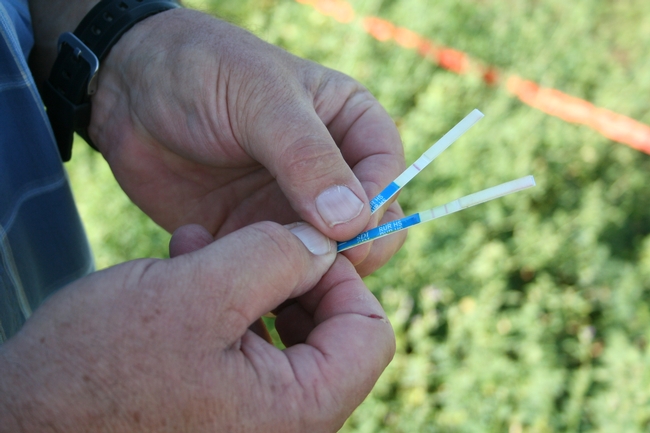- Author: Jeffery A. Dahlberg
The U.S. Grains Council sponsored a team of managers from leading dairies in China to visit local dairy operations in California, discuss feed and nutrition issues, and to attend the World Dairy Expo in Chicago. The team, made up of nutritionists, farm managers, and general managers met with Jeff Dahlberg, Director of the Kearney Agricultural Research and Extension Center, and sorghum expert to discuss the potential use of sorghum forages and grain for dairy feed. Dahlberg spent several hours providing the delegation with a field tour and lecture on “what is sorghum” and its potential use as a low input, low water source for nutritious dairy feed. Dahlberg is investigating the potential of sorghum for dairies in California and information about its potential and evaluation of potential commercial sorghum forage hybrids can be found at sorghum.ucanr.edu.

- Author: Laura J. Van der Staay
Kearney is participating in a $12.3M study of crop drought tolerance funded by the US Department of Energy. The five-year project is called Epigenetic Control of Drought Response in Sorghum, or EPICON. Peggy Lemaux, cooperative extension specialist at UC Berkeley's Department of Plant and Microbial Biology, is heading the entire project. Co-investigators are Devin Coleman-Derr, Elizabeth Purdom and John Taylor from UC Berkeley; Jeffrey Dahlberg and Robert Hutmacher from UC Agriculture and Natural Resources; Chia-Lin Wei from the DOE Joint Genome Institute; and Christer Jansson from the Pacific Northwest National Laboratory.
Sorghum will be studied to explore the epigenetic mechanisms that allow a crop to survive drought conditions. Epigenetic modifications turn genes on or off without modifying the DNA sequence.
“Historically, the genetic manipulation of crops, which has been critical to increasing agricultural productivity, has concentrated on altering the plant's genetic sequence, encoded in its DNA,” said Lemaux. “However, recent studies have shown that environmental stresses – in our case drought – can lead to epigenetic changes in a plant's genetic information. Because epigenetic changes occur without altering the underlying DNA sequence, they allow plants to respond to a changing environment more quickly.”
For The Daily Californian article, please click here.
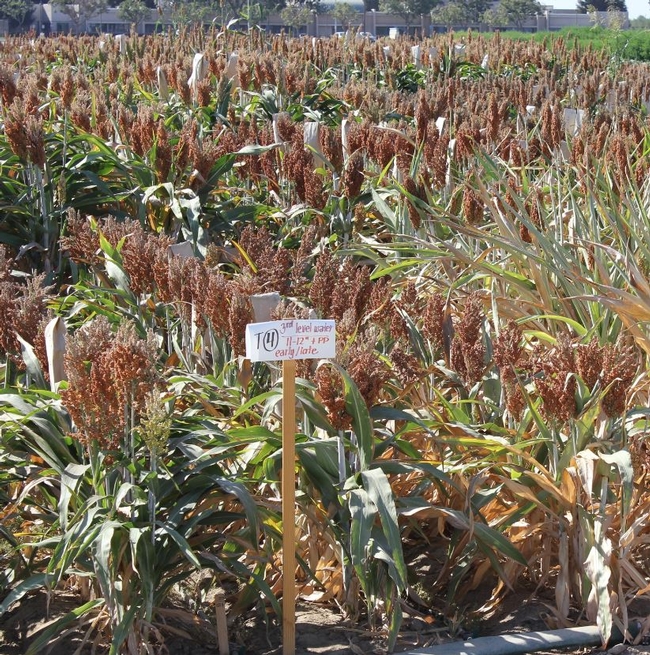
- Author: Laura J. Van der Staay
- Contributor: Patrick Cavanaugh
The recent alfalfa and forage meeting at Kearney attracted about 100 growers and pest control advisors.
Shannon Mueller, UC Cooperative Extension advisor and director in Fresno County, agronomy, alfalfa, hay, forage crops, honeybees, seed oil crops, and dry beans, indicated that grower knowledge of the local pest and disease pressure and selection of an alfalfa variety with desired resistance qualities is an effective IPM tool for managing pests and disease in alfalfa crops.
Dan Putnam, extension specialist in the Department of Plant Sciences at UC Davis, agronomy, alfalfa and forage crops, alternative field crops, cellulosic energy crops, crop ecology, shared that some of the nitrogen produced by alfalfa (a legume) remains and is available for subsequent crops. Current research has a goal of developing alfalfa’s nitrogen credit to help manage nitrogen fertilizer supplementation for non-legume rotational crops (like wheat). Putnam also shared the potential value of sorghum as a summer irrigated forage crop for dairy and livestock production that requires less water and nitrogen as compared to corn (California’s main forage crop). Research on the sorghum is ongoing, with benefits and limitations being identified.
Michelle Leinfelder-Miles, UC Cooperative Extension advisor in San Joaquin, Contra Costa, Sacramento, Solano and Yolo counties, crop production, soil and water quality, the Delta, discussed concerns and management strategies related to the co-existence of Roundup Ready (RR) alfalfa and conventional alfalfa. Gene flow between seed producing alfalfa fields has been observed. Gene flow between hay producing alfalfa fields is mainly prevented by management barriers, particularly the cutting of hay at a stage that minimizes any seed development. Best practices to allow growing and separating both RR and conventional alfalfa were discussed. Additionally, growers can use test strips that allow easy and quick detection al RR alfalfa if customers do not want any RR alfalfa.
Jeffery Dahlberg, director at Kearney Agricultural Research & Extension Center, plant breeding, agronomy, field crops, sorghum, plant production, plant genetics, discussed sorghum variety trials designed to assess many characteristics, including water use, fertility, forage quality and yield. Dahlberg indicated that sorghum serves as a grain and forage crop for livestock, and biofuel crop.
Robert Hutmacher, cooperative extension specialist and director at West Side Research & Extension Center, cotton production issues, water stress, nutrient management, indicated that water conservation is a high priority. Hutmacher highlighted water timing and reduction research that indicated that although yields are lowered with less water, acceptable sorghum crop yields can still be obtained. Yields of grain sorghum were impacted less than yields of forage sorghum with reduced water use.
Steven Wright, UC Cooperative Extension advisor in Tulare and Kings counties, cotton, small grains, weed control, discussed how nitrogen/wheat variety management strategies help maximize both yield and protein levels while minimizing ground water contamination in growing areas.
Larry Godfrey, UC Cooperative Extension Specialist in the Department of Entomology, UC Davis, entomology, discussed the Blue Alfalfa Aphid, which caused extensive economic damage throughout California last year. The Blue Alfalfa Aphid was a major problem in the 1970s, and a minor problem in the interim. The pest management materials that were effective historically were not effective last year. New pest management strategies have been developed and a new use registration and/or section 18 use permit are pending, hopefully in time for the 2014 alfalfa growing season.
Kurt Hembree, UC Cooperative Extension Specialist in Fresno County, weed management strategies in crop and non-crop settings, discussed weed management strategies for RR and conventional alfalfa stands. Hembree indicated that best practices are to design weed management strategies according to existing and anticipated weeds with extra weed control effort during early stand development. Hembree stressed that if growers want to preserve the benefits created by RR alfalfa, they need to reduce the chances of weed resistance to glyphosate with escapes control, mode of action rotation, and/or tank-mixing with other herbicides.
For more information, please look at the California Ag Today blog.

- Posted By: Jeannette E. Warnert
- Written by: Jennifer Blackburn

Dahlberg served as research director for the National Sorghum Producers and the United Sorghum Checkoff Program. He also previously served as the USDA Agricultural Research Service (ARS) curator for sorghum. He returned to his home state of California in December 2010 to work as director of the Kearney Agricultural Research and Extension Center in Parlier, Calif.
Dahlberg has worked tirelessly to strengthen sorghum research to promote the crop and increase industry opportunities. His accomplishments in the sorghum industry include increasing federal sorghum funds to USDA-ARS by more than $6 million, introducing 200 new exotic parents into the Sorghum Conversion Program, and re-evaluating and improving genetic sorghum descriptors, which have been used to collect data on nearly 8,500 accessions of sorghum growing in various regenerations.
He is the past president of the Whole Grains Council, served as chair of the Sorghum and Millet Germplasm Committee, and was formerly the secretary of the International Sorghum Genomics Committee that worked to get sorghum sequenced. He also led research efforts in conjunction with National Renewable Energy Laboratory (NREL) on a U.S. Department of Energy Sorghum to Ethanol grant.
“This is the highest award for a member of the sorghum community,” said Bruce Maunder, research advisor for the United Sorghum Checkoff Program, who also received the award in 1985. “Jeff is very deserving of such recognition for his contributions to this industry.”
NSP congratulates Dahlberg on this honor and is grateful for his contributions to the U.S. sorghum industry.
Jennifer Blackburn is communications coordinator for National Sorghum Producers.
- Author: Jeannette E. Warnert
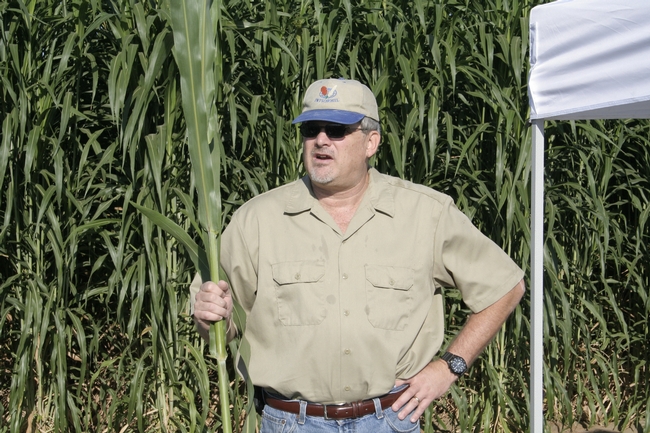
Dahlberg introduced San Joaquin Valley farmers to a new sorghum variety trial during the Alfalfa Field Day Sept. 8. The trial, which compares 80 varieties of forage sorghum, is also being conducted at the UC West Side Research and Extension Center in Five Points, Calif. At Kearney, the 10- to 12-foot-high plants were grown in 84 days with just 8 inches of irrigation water.
"I'm going to push this to be a sorghum state," said Dahlberg, who came to California in January from Texas, where he was director of research for the United Sorghum Checkoff Board. "I'm not suggesting you take out all your corn forage, but experiment with this a little. There is no reason you shouldn't grow forage sorghum."
Dahlberg said the crop could be useful in rotation with traditional California crops, like cotton and corn.
"There are lots of acres on the West Side that I think could benefit with sorghum rotation," he said.
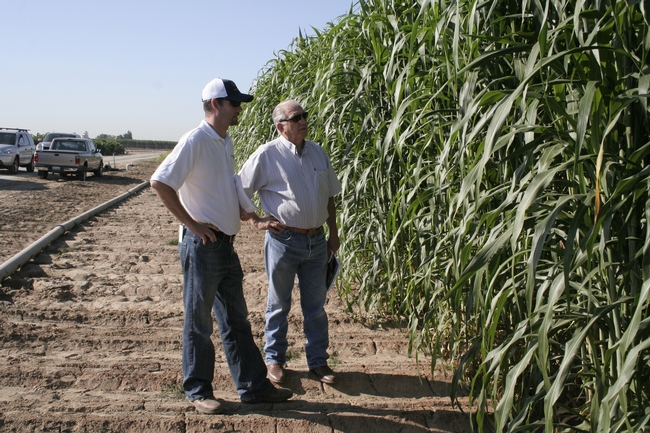
Alfalfa trials
Alfalfa Field Day participants also viewed alfalfa growing at Kearney as part of an extensive, statewide alfalfa variety trial. Similar plots are being maintained at UC's Intermountain Research and Extension Center, about two miles south of the Oregon border, at the Desert Research and Extension Center, about 10 miles north of the Mexican border, and at several locations in between.
UC Cooperative Extension alfalfa specialist Dr. Dan Putnam said the data gathered in these trials are provided to growers on the UC Alfalfa and Forage website to help them select a variety to grow, a decision Putnam admonished farmers not to take lightly.
"You are 'stuck' with your variety decision for many years," Putnam said. "So why not take a little care in choosing your variety?"
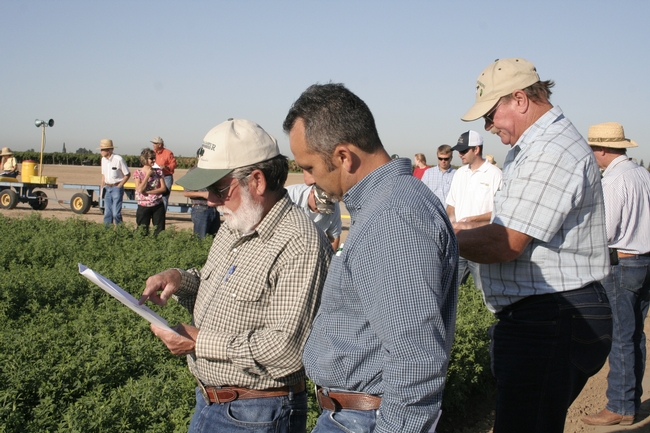
Putnam also described an alfalfa trial at Kearney where a Roundup Ready cultivar is growing across the road from a conventional crop. During the first year of the study, tests have shown that there has been no discernible gene flow between the two fields.
Alfalfa grown for seed requires honey bee pollination and has different isolation requirements than hay, he said. A three-mile buffer must be maintained for production of Roundup Ready seed and a five-mile buffer is required for seed grown for markets sensitive to a genetically-engineered trait. However, alfalfa hay crops can be grown in close proximity with very low risk of contamination if growers follow a few simple steps.
Putnam believes that non-GMO farmers can coexist with conventional farmers by using some of the same good-neighbor farming accords that have long been common in agriculture.
"There is a human factor involved," Putnam said. "Neighbors have to get along and respect each others' points of view."
One way for farmers and buyers to be certain a non-GMO crop doesn't have the Roundup Ready gene is with a simple, commercially available test that can be used in the field or on baled hay, shown below.
